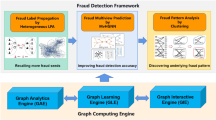Abstract
Fraudulent user detection is a crucial issue in financial risk management. Due to the lack of labeled data and the reliability of labeling, label propagation algorithms (LPA) are effective solutions in this scenario. Most existing models only propagate the risk probabilities for individual users through feature level, while ignoring the real-world graph structure and the characteristics of gang crime. This paper improves the graph-based LPA through group partition, which can be directly implemented on the graph at hand with full consideration of the group information. The exhaustive experimental results testify the performance of our proposed model KGLPA over other off-the-shelf models and amend the insufficiency of feature-based LPA with higher reliability and stability to improve the detection of fraudulent users and secure the marketing budgets.







Similar content being viewed by others
References
Internet Crime Complaint Center (2019) Internet Crime Report[EB/OL]. https://pdf.ic3.gov/2019_IC3Report.pdf
Fastoso F, Bianchi C, Andrews L (2012) Risk, trust, and consumer online purchasing behaviour: a chilean perspective[J]. Int Mark Rev 29(3):253–275
West J, Bhattacharya M (2016) Intelligent financial fraud detection: a comprehensive review[J]. Comput Secur 57:47–66
Huang G, Song S, Gupta JND et al (2017) Semi-supervised and unsupervised extreme learning machines[J]. IEEE Trans Cybernet 44(12):2405–2417
Kim K, Lee J (2014) Sentiment visualization and classification via semi-supervised nonlinear dimensionality reduction[J]. Pattern Recogn 47(2):758–768
Tackett JA (2013) Association rules for fraud detection[J]. J Corp Acc Financ 24(4):15–22
Ruiz MD, Martinbautista MJ, Daniel Sánchez et al (2014) Anomaly detection using fuzzy association rules[J]. Int J Electron Secur Digit Forensics 6(1):25–37
Wang S, Liu C, Gao X et al. Session-based fraud detection in online e-commerce transactions using recurrent neural networks. Joint European Conference on Machine Learning and Knowledge Discovery in Databases. Springer, Cham, 2017:241–252
Hoque F, Jahidul Islam M, Shatabda S (2015) A two-tier classification model for financial fraud detection[J]. Catal Commun 8(12):2007–2011
Dong Yanan L, Xuejun L (2016) Click fraud detection method based on user behavior feature selection [J]. Comput Sci 43(10):145–149
Fiore U, Santis AD, Perla F et al (2019) Using generative adversarial networks for improving classification effectiveness in credit card fraud detection[J]. Inf Sci 479:448–455
Zhang L, Yang J, Tseng B (2012) Online modeling of proactive moderation system for auction fraud detection[C]. International Conference on World Wide Web. ACM, New York
Bhuyan MH, Bhattacharyya DK, Kalita JK (2016) A multi-step outlier-based anomaly detection approach to network-wide traffic[J]. Inf Sci 348:243–271
Campos GO, Zimek A, Sander J et al (2016) On the evaluation of unsupervised outlier detection: measures, datasets, and an empirical study. Data Min Knowl Disc 30(4):891–927
Janaina MM, Hardoon DR, Tim H et al (2011) Patient classification as an outlier detection problem: an application of the one-class support vector machine[J]. Neuroimage 58(3):793–804
Zhu X, Ghahramani Z. Learning from labeled and unlabeled data with label propagation[R]. Tech. Rep., Technical Report CMU-CALD-02–107, Carnegie Mellon University, 2002
Wang F, Zhang C (2007) Label propagation through linear neighborhoods[J]. IEEE Trans Knowl Data Eng 20(1):55–67
Wang B, Tu Z, Tsotsos JK (2013) Dynamic label propagation for semi-supervised multi-class multi-label classification[C]. Proceedings of the IEEE international conference on computer vision. pp 425–432
Lin Y, Hu X, Wu X (2014) Ensemble learning from multiple information sources via label propagation and consensus[J]. Appl Intell 41(1):30–41
Zoidi O, Fotiadou E, Nikolaidis N et al (2015) Graph-based label propagation in digital media: a review[J]. ACM Comput Surv 47(3):1–35
Lu M, Zhang Z, Qu Z et al (2018) LPANNI: Overlapping community detection using label propagation in large-scale complex networks[J]. IEEE Trans Knowl Data Eng 31(9):1736–1749
Liu X, Zhao D, Zhou J et al (2014) Image interpolation via graph-based bayesian label propagation[J]. IEEE Trans Image Process 23(3):1084–1096
Liu JW, Liu Y, Luo XL (2015) Semi-supervised learning methods[J]. Chin J Comput 38(08):1592–1617
Ye W, Zhou L, Mautz D et al (2017) Learning from labeled and unlabeled vertices in networks[C]. Proceedings of the 23rd ACM SIGKDD International Conference on Knowledge Discovery and Data Mining. pp 1265–1274
Faerman E, Borutta F, Busch J, et al. Semi-supervised learning on graphs based on local label distributions[EB/OL]. https://arxiv.org/pdf/1802.05563.pdf, 2018-05-23/2019-07-08
Zhang Z, Cui P, Zhu W. Deep learning on graphs: A survey[EB/OL]. https://arxiv.org/pdf/1812.04202v1.pdf, 2018-12-11/2019-07-08
Defferrard M, Bresson X, Vandergheynst P (2016) Convolutional neural networks on graphs with fast localized spectral filtering[C]. Advances in neural information processing systems. pp 3844–3852
Kipf TN, Welling M (2017) Semi-supervised classification with graph convolutional networks[C]. International Conference on Learning Representations
Veličković P, Cucurull G, Casanova A, et al (2018) Graph attention networks[C]. International Conference on Learning Representations
Hamilton W, Ying Z, Leskovec J (2017) Inductive representation learning on large graphs[C]. Advances in neural information processing systems. pp 1024–1034
Acknowledgements
This research is financially supported by The National Key Research and Development Program of China (grant number 2018YFC0807105), National Natural Science Foundation of China (grant number 61462073) and Science and Technology Committee of Shanghai Municipality (STCSM) (under grant numbers 17DZ1101003, 18511106602 and 18DZ2252300).
Author information
Authors and Affiliations
Corresponding author
Additional information
Publisher's note
Springer Nature remains neutral with regard to jurisdictional claims in published maps and institutional affiliations.
Rights and permissions
About this article
Cite this article
Wang, J., Guo, Y., Wen, X. et al. Improving graph-based label propagation algorithm with group partition for fraud detection. Appl Intell 50, 3291–3300 (2020). https://doi.org/10.1007/s10489-020-01724-1
Received:
Revised:
Accepted:
Published:
Issue Date:
DOI: https://doi.org/10.1007/s10489-020-01724-1




